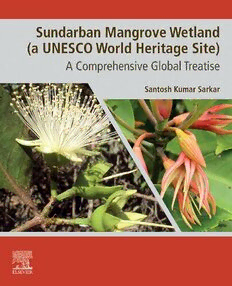
Sundarban Mangrove Wetland (A UNESCO World Heritage Site): A Comprehensive Global Treatise PDF
Preview Sundarban Mangrove Wetland (A UNESCO World Heritage Site): A Comprehensive Global Treatise
Sundarban Mangrove Wetland (a UNESCO World Heritage Site) A Comprehensive Global Treatise This pageintentionallyleftblank Sundarban Mangrove Wetland (a UNESCO World Heritage Site) A Comprehensive Global Treatise Santosh Kumar Sarkar Department of Marine Science, University of Calcutta, Kolkata, India Elsevier Radarweg29,POBox211,1000AEAmsterdam,Netherlands TheBoulevard,LangfordLane,Kidlington,OxfordOX51GB,UnitedKingdom 50HampshireStreet,5thFloor,Cambridge,MA02139,UnitedStates Copyright©2022ElsevierInc.Allrightsreserved. Nopartofthispublicationmaybereproducedortransmittedinanyformorbyanymeans,electronic ormechanical,includingphotocopying,recording,oranyinformationstorageandretrievalsystem, withoutpermissioninwritingfromthepublisher.Detailsonhowtoseekpermission,further informationaboutthePublisher’spermissionspoliciesandourarrangementswithorganizationssuch astheCopyrightClearanceCenterandtheCopyrightLicensingAgency,canbefoundatourwebsite: www.elsevier.com/permissions. Thisbookandtheindividualcontributionscontainedinitareprotectedundercopyrightbythe Publisher(otherthanasmaybenotedherein). Notices Knowledgeandbestpracticeinthisfieldareconstantlychanging.Asnewresearchandexperience broadenourunderstanding,changesinresearchmethods,professionalpractices,ormedical treatmentmaybecomenecessary. Practitionersandresearchersmustalwaysrelyontheirownexperienceandknowledgeinevaluating andusinganyinformation,methods,compounds,orexperimentsdescribedherein.Inusingsuch informationormethodstheyshouldbemindfuloftheirownsafetyandthesafetyofothers,including partiesforwhomtheyhaveaprofessionalresponsibility. Tothefullestextentofthelaw,neitherthePublishernortheauthors,contributors,oreditors,assume anyliabilityforanyinjuryand/ordamagetopersonsorpropertyasamatterofproductsliability, negligenceorotherwise,orfromanyuseoroperationofanymethods,products,instructions,orideas containedinthematerialherein. ISBN:978-0-12-817094-6 ForInformationonallElsevierpublications visitourwebsiteathttps://www.elsevier.com/books-and-journals Publisher:CandiceJanco AcquisitionsEditor:LouisaMunro EditorialProjectManager:RachelPomery/SaraGreco ProductionProjectManager:SruthiSatheesh CoverDesigner:MarkRogers TypesetbyMPSLimited,Chennai,India Dedication Dedicated to all those deeply involved in conservation, management, and wise use of the Mangrove Wetlands This page intentionallyleftblank Contents Foreword..................................................................................................................xv Preface..................................................................................................................xvii Acknowledgments..................................................................................................xix Abbreviations and acronyms...............................................................................xxiii CHAPTER 1 Resource conservation and management....................1 1.1 Classification andcharacteristicsof coastal wetlands...................1 1.2 Mangrove flora andfauna..............................................................3 1.2.1 Characteristics of mangrove plantspecies.......................3 1.2.2 Characteristics of temperate mangroves...........................5 1.2.3 Floristic composition ofmangroves inIndia...................5 1.2.4 Mangrove community inother global regions...............38 1.2.5 Global mangrove cover...................................................48 1.2.6 Biogeographical division................................................50 1.2.7 Classification of mangrove landforms............................53 1.2.8 Structure andadaptation strategies ofMangroves.........55 1.2.9 Endangered species in mangrove regions of the worldand their conservation strategies..........................59 1.2.10 Conclusion.......................................................................69 1.3 Mangroves goods andecosystem services..................................70 1.4 Mangroves:A carbon source and sink........................................78 1.5 Remote-sensing techniques for mangrove mapping....................84 References....................................................................................92 CHAPTER 2 Ecology and diversity of biota in Sundarban regions.......................................................................119 Subchapter 2.1 Distribution and diversity of microbial communities..........................................................120 2.1.1 Bacterial communities................................................................120 2.1.2 Fungal communities...................................................................123 2.1.3 Conclusion..................................................................................127 References..................................................................................127 Subchapter 2.2 Distribution and diversity of phytoplankton of Sundarban.............................................................132 2.2.1 Introduction................................................................................132 2.2.2 Classification ofplankton..........................................................133 2.2.3 Phytoplankton communityin Sundarbanregions......................133 vii viii Contents 2.2.4 Phytoplanktoncell volume inIndianSundarban......................136 2.2.5 Molecular characterization ofphytoplankton............................136 2.2.6 Phytoplanktoncommunity intropical coastal regions..............139 2.2.7 Phytoplanktonresponses toclimatechange..............................139 2.2.8 Conclusion..................................................................................141 References..................................................................................141 Subchapter 2.3 Distribution and diversity of microzooplankton (Tintinnida: Ciliata) of Sundarban: a case study..........................................................143 2.3.1 Introduction................................................................................143 2.3.2 Materialsand methods...............................................................144 2.3.2.1 Study sites...............................................................144 2.3.2.2 Sampling strategyand analyticalprotocol.............144 2.3.2.3 Data analysisof sample..........................................145 2.3.3 Results and discussion................................................................145 2.3.3.1 Environmental variables.........................................145 2.3.3.2 Taxonomic composition,community structure, andseasonal species distribution............................147 2.3.3.3 Tintinnidnumericaldensity, biomass and production rate........................................................150 2.3.3.4 Effect of algal bloom on tintinnidcommunity structure...................................................................151 2.3.3.5 Correlationsbetween tintinnidcommunities and environmental variables..........................................153 2.3.4 Conclusion..................................................................................156 References..................................................................................157 Subchapter 2.4 Distribution and diversity of mesozooplankton of Sundarban: a case study..................................160 2.4.1 Introduction................................................................................160 2.4.2 Materialsand methods...............................................................161 2.4.2.1 Study area, sampling,and sample processing........161 2.4.3 Results and discussion................................................................162 2.4.3.1 Environmental variables.........................................162 2.4.3.2 Mesozooplankton displacement values..................163 2.4.3.3 Copepod..................................................................164 2.4.3.4 Distribution of chaetognathand itsmaturity stages.......................................................................168 2.4.3.5 Statistical analyses..................................................169 2.4.4 Conclusion..................................................................................172 References..................................................................................173 Contents ix Subchapter 2.5 Distribution and diversity of dominant macrobenthos........................................................179 2.5.1 Introduction................................................................................179 2.5.2 Cnidarian....................................................................................181 2.5.3 Annelida.....................................................................................181 2.5.4 Arthropoda..................................................................................185 2.5.5 Mollusca.....................................................................................189 2.5.6 Echinodermata............................................................................192 2.5.7 Miscellaneous groups.................................................................192 2.5.8 Conclusion..................................................................................193 References..................................................................................194 Subchapter 2.6 Distribution and diversity of Ichthyofauna...........196 2.6.1 Introduction................................................................................196 2.6.2 Morphology and taxonomyof marinefish................................197 2.6.3 Distributionof marinefish.........................................................198 2.6.4 Impact of anthropogenic threats on fish....................................207 2.6.5 Conclusion..................................................................................211 References..................................................................................212 Subchapter 2.7 Distribution and diversity of avifauna..................213 References..................................................................................230 Subchapter 2.8 Distribution and diversity of herpetofauna..........232 References..................................................................................242 Subchapter 2.9 Distribution and diversity of mammals................243 References..................................................................................253 CHAPTER 3 Pollution in abiotic matrices and remedial measures...................................................................255 Subchapter 3.1 Distribution of trace metals in sediment core of Sundarban: a case study......................................255 3.1.1 Introduction................................................................................256 3.1.2 Material and methods.................................................................256 3.1.2.1 Collection, preservation, and chemical analyses ofsediment samples.................................256 3.1.3 Results anddiscussion................................................................257 3.1.3.1 Sediment geochemistry...........................................257 3.1.3.2 Variation oftrace metals insedimentcores...........257 3.1.3.3 Evaluation ofsedimentcontamination and ecological risks........................................................261
